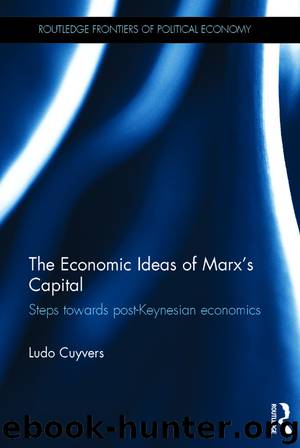The Economic Ideas of Marx's Capital by Cuyvers Ludo;

Author:Cuyvers, Ludo;
Language: eng
Format: epub
Publisher: Routledge
Published: 2016-08-24T16:00:00+00:00
6.2 The rate of profits in the linear production model
We will now “translate” the rate of profits into the language of the linear production model. As before, it is assumed that there is no fixed capital, in that all capital is circulating. In addition, we assume that capital circulates once during a particular production period. In other words, in all sectors capital is earned back during that period.
It appears from the linear production model that the general rate of profits, irrespective of what the prices of production or the labour values are, is a number that is determined by the necessary physical inputs of the means of production and the necessary consumer goods of the workers involved. This implies that the rate of profits is not based on the prices of production but, conversely, that the prices of production depend on the rate of profits.
This is an obvious deduction if we consider an economy in which only one good is produced, e.g. wheat. If 10 kg of wheat are needed as seed for sowing, which will be combined with 100 hours of labour time to cultivate 100 kg of wheat, and if we take as given that 0.5 kg of wheat is required as necessary consumption, or 50 kg of wheat for 100 working hours, then the price of production p2 of 1 kg of wheat should obey the following equality:
(10 p2 + 50 p2) (1 + r) = 60 p2 (1 + r) = 100 p2
Download
This site does not store any files on its server. We only index and link to content provided by other sites. Please contact the content providers to delete copyright contents if any and email us, we'll remove relevant links or contents immediately.
International Integration of the Brazilian Economy by Elias C. Grivoyannis(71222)
The Radium Girls by Kate Moore(11584)
Turbulence by E. J. Noyes(7672)
Nudge - Improving Decisions about Health, Wealth, and Happiness by Thaler Sunstein(7206)
The Black Swan by Nassim Nicholas Taleb(6731)
Rich Dad Poor Dad by Robert T. Kiyosaki(6129)
Pioneering Portfolio Management by David F. Swensen(6048)
Man-made Catastrophes and Risk Information Concealment by Dmitry Chernov & Didier Sornette(5611)
Zero to One by Peter Thiel(5457)
Secrecy World by Jake Bernstein(4354)
Millionaire: The Philanderer, Gambler, and Duelist Who Invented Modern Finance by Janet Gleeson(4060)
The Age of Surveillance Capitalism by Shoshana Zuboff(3964)
Skin in the Game by Nassim Nicholas Taleb(3951)
The Money Culture by Michael Lewis(3806)
Bullshit Jobs by David Graeber(3797)
Skin in the Game: Hidden Asymmetries in Daily Life by Nassim Nicholas Taleb(3707)
The Dhandho Investor by Mohnish Pabrai(3542)
The Wisdom of Finance by Mihir Desai(3503)
Blockchain Basics by Daniel Drescher(3306)
